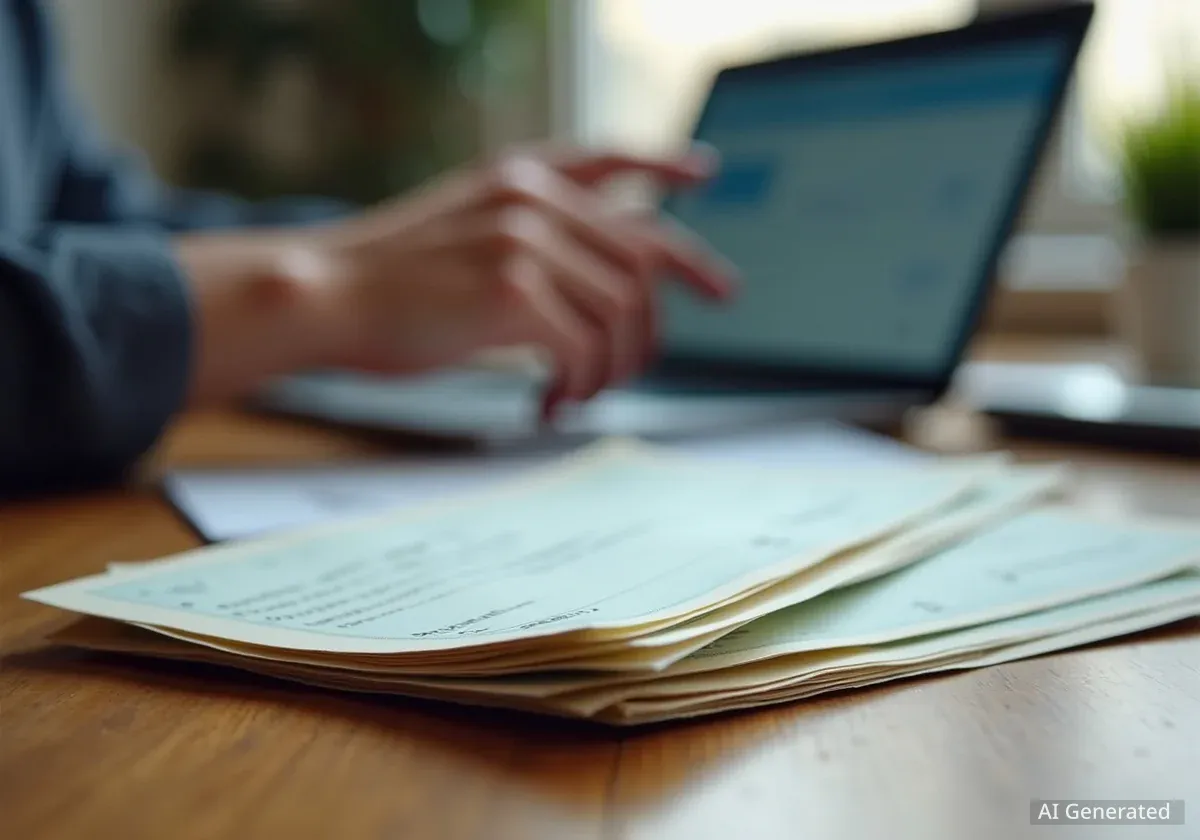The Social Security Administration (SSA) has announced a significant change to its payment distribution system, confirming that it will cease issuing paper checks for benefits after September 30, 2025. This move will require hundreds of thousands of beneficiaries to transition to an electronic payment method to avoid potential disruptions.
According to the agency, this change is part of a larger federal initiative to modernize payments and enhance security. As of July, over 500,000 individuals were still receiving their benefits via physical mail, and they are now being urged to enroll in an electronic option before the deadline.
Key Takeaways
- Deadline Approaching: Social Security will stop issuing paper checks after September 30, 2025.
- Action Required: Beneficiaries currently receiving checks must switch to an electronic payment method.
- Payment Options: The two primary options are direct deposit into a bank account or a Direct Express® prepaid debit card.
- Reason for Change: The transition aims to reduce costs, increase security, and prevent payment delays associated with mail service.
Federal Mandate Drives Payment Modernization
The decision to phase out paper checks is not an isolated policy from the Social Security Administration. It stems from a broader government-wide mandate established by Executive Order 14247, titled "Modernizing Payments To and From America's Bank Account." This order, signed by former President Donald Trump in March 2025, directs all federal agencies to transition their disbursements to electronic methods.
The mandate covers a wide range of federal payments, including Social Security, Supplemental Security Income (SSI), Social Security Disability Insurance (SSDI), payments to vendors, and even tax refunds from the IRS. The goal is to create a more efficient, secure, and cost-effective system for distributing government funds.
Background on the Executive Order
Executive Order 14247 was issued to address long-standing issues with physical checks. The White House cited significant problems, including mail theft, lost payments, and fraud. The order aims to protect taxpayer money and ensure that recipients receive their funds reliably and on time by leveraging modern electronic payment systems.
According to SSA records from July, a total of 521,644 benefit payments were still being sent as physical checks. While this represents a small percentage of the nearly 70 million Americans who receive Social Security and SSI benefits each month, the deadline directly impacts this specific group of recipients who have not yet transitioned to a digital format.
The High Cost and Risk of Paper Checks
The federal government's push toward electronic payments is heavily supported by data highlighting the inefficiencies and vulnerabilities of the traditional check system. A White House fact sheet released with the executive order detailed the compelling reasons for the change.
One of the primary drivers is cost. Maintaining the infrastructure for printing and mailing paper checks is a significant expense for taxpayers. The White House reported that this system cost more than $657 million in Fiscal Year 2024 alone. By eliminating this process, the government anticipates substantial savings.
Increased Risk of Fraud and Theft
According to U.S. Treasury data, paper checks are 16 times more likely to be reported lost, stolen, returned as undeliverable, or fraudulently altered compared to electronic payments. Complaints of mail theft have also risen significantly since 2020, making checks a prime target for criminals.
Beyond the financial costs, the risk of fraud and payment disruption poses a direct threat to beneficiaries who rely on these funds for their daily living expenses. Lost or stolen checks can lead to lengthy delays while the SSA investigates and reissues the payment, causing financial hardship for vulnerable individuals. The SSA has emphasized that electronic payments provide a much safer and more reliable method for receiving benefits.
How Beneficiaries Can Switch to Electronic Payments
The SSA has urged all recipients still receiving paper checks to act promptly to ensure a seamless transition and avoid any interruption in their payments. The agency provides two straightforward and secure options for receiving benefits electronically.
Option 1: Direct Deposit
Direct deposit is the most common electronic method, automatically placing funds into a recipient's bank or credit union account on the scheduled payment date. This option offers immediate access to money without the need to visit a bank to cash a check.
- How to Enroll: Beneficiaries can set up or manage their direct deposit information through their personal my Social Security account online.
- Assistance: For those needing help, the SSA can be reached by phone at 1-800-772-1213. This number is available for Social Security, SSI, and international beneficiaries.
Option 2: Direct Express® Debit Card
For individuals who do not have a bank account, the Direct Express® prepaid debit card is the recommended alternative. The card is issued by Comerica Bank on behalf of the U.S. Treasury.
Benefit payments are loaded onto the card each month, and it can be used to make purchases, pay bills, and get cash at ATMs or retail locations that accept Mastercard®.
- How to Enroll: Enrollment can be completed by calling the Direct Express® card center at 1-800-333-1795 or by visiting their official website at www.usdirectexpress.com.
- Benefits: This option eliminates check-cashing fees and the risk of a check being lost or stolen from a mailbox.
In a recent post on the social media platform X, the SSA stated, "Social Security is switching to electronic payments! If you still get paper checks, act now to avoid payment delays. Enroll in direct deposit or Direct Express by Sept. 30."
Understanding the Exceptions
While the mandate for electronic payments is comprehensive, the Social Security Administration has acknowledged that a small number of cases may require an exception. The agency has clarified that it will not withhold payments from individuals who are unable to make the switch.
An SSA spokesperson confirmed the agency's position on these unique situations, ensuring that no beneficiary will be left without access to their funds.
"Where a beneficiary has no other means to receive payment, we will continue to issue paper checks."
These exceptions are expected to be rare and will be handled on a case-by-case basis. However, the strong recommendation from the SSA is for all eligible beneficiaries to enroll in an electronic option as soon as possible. Agency technicians are available to provide assistance and answer any questions to facilitate a smooth transition before the September 30, 2025 deadline.





